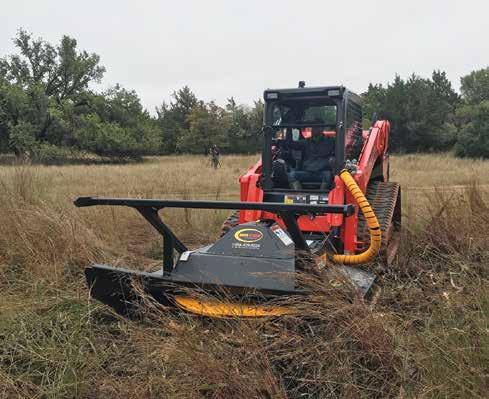
9 minute read
Dr. Deer’s Prescription
Plant Wars
By Dr. James C. Kroll

Prescribed fire is the least expensive way to manage habitats for whitetails.

We have likened deer management to a three-legged stool: one leg representing habitat; another, populations; and the last one, people management. We chose a threelegged stool because if you remove one leg, you will fall on your behind. So, any whitetail management program has to address each of the three elements. In this column, I will address one aspect of habitat management—manipulating vegetation to benefit your deer. The white-tailed deer is about 3-4 feet tall (the “Deer Zone”), so everything it needs in the way of nutrition has to be available in this zone. Deer management, even in South and West Texas, is a “war against vegetation.” You must implement practices that favor the plant species deer prefer and keep them in reach of your deer. In the eastern half of Texas, vegetation will grow above the deer zone in 3-5 years, while in drier portions of the region it may take 7-10 years. You have three “tools” to manage vegetation: fire, mechanical treatments, and chemicals.
Fire
When western man arrived in North America, he encountered a landscape already influenced by man. For thousands of years, Native Americans had used fire to manipulate vegetation to improve game production and control pests such as ticks. Native Americans once considered the Post Oak Savanna region of Texas as a fruitful hunting ground. They kept the region in a savannastate grassland with scattered trees by using fire. When early explorers first saw these savannas, they recorded that they saw what appeared to be herds of wild horses; which actually were whitetails.
The beautiful longleaf pine stands of the South once existed in a restricted region along the Southeast Coast, but periodic fires helped expand its range to eastern Texas. North America’s new inhabitants considered fire dangerous, and steps were taken to prevent the “wild fires.” The result was development
of unnaturally dense forests and brush that no longer possessed their productive capacity for wildlife. Even today, fire is viewed and reported as detrimental and destructive and billions are spent each year to deal with the consequences of protecting unnatural ecosystems.
Wildlife managers use controlled versions of what the Native Americans did to manage wildlife. Unfortunately, however, public sentiment continues to frustrate these efforts. Sadly, I believe the day is near when we will lose fire as a management tool. Years of “education” and media exposure has eroded public acceptance of prescribed fire. That means wildlife managers and landowners will have to rely more and more on the remaining two vegetation management options.
Mechanical vegetation management
Wide arrays of mechanical vegetation management options are available to the wildlife manager. Unfortunately, however, they come at a much higher cost than fire. These include: • Timber harvest and thinning • Roller-chopping • Shearing • Chaining • Disking
I listed these in ascending order of impact on the ecosystem being managed. The general idea is to push natural succession—the stepwise development of plant communities after disturbance—backward to improve deer forages. Of the five options, I discourage the last two in many cases because they reduce the diversity of deer forage plants—browse. My colleague and friend, the late Dr. John J. Stransky, was a pioneer in vegetation management in the South. His research clearly illustrated that roller-chopping tends to produce plant communities with an approximate balance of forage types: grasses, forbs (weeds) and shrubs (browse). We use roller-chopping in dry climates to improve deer foods, even in Mexico. Roller-chopping, followed later by prescribed fire is a powerful management tool, but again, fire often is not practical. Mechanical treatments vary in cost, with the most dramatic manipulation being the most expensive. Roller-chopping costs from $30-$60 per acre (highly variable), while burning costs on average $25 per acre using a professional applicator. The equipment—bulldozer and rollerchopper—costs upward of $100,000.
Chemical treatments
More and more, vegetation management involves use of chemicals called herbicides, or “plant killers.” Per-acre cost is in the range of roller-chopping, depending on the intensity of desired impact. Unfortunately, herbicides have a “bad rap” due to media coverage of herbicide use in Vietnam in the 1960s. I consider herbicides as important wildlife management tools, as long as they are properly and responsibly applied.
As far as I am concerned, the “tank mixes” (mixtures of several herbicides) used in forest site preparation are harmful to wildlife communities, because they deliberately reduce plant species diversity to benefit crop tree growth. Further, the use of genetically manipulated crops (GMOs) has seen serious reduction in plant species diversity and appearance of herbicide resistant noxious weeds. I want to make clear, however that the proper use of herbicides for wildlife management is a sound practice, as long as proper chemicals and application rates are employed. We recommend you acquire a pesticide applicator’s license from your state agricultural department (www.texasagriculture.gov).
Proper use of herbicides involved recommended application rates, timing, and equipment. My colleague and herbicide expert, Dr. Jimmie Yeiser, once said: “The average landowner measures his chemicals in ‘glugs’: glug, glug, and glug!” Now, let’s look at the common herbicides that have application to habitat management. This is not meant to present a complete list of chemicals, only those we have found useful.
Proper application of herbicides includes consideration of temperature and wind velocity, as well as possible impacts on non-target areas and hazards. So, you can see why training is essential in herbicide use.

Glyphosate
Probably the best-known herbicide, glyphosate—aka, RoundUp—is the most used chemical today in vegetation management and control. Go to any gardening department and you will see impressive shelf space devoted to this herbicide. It comes normally in a 41 percent stock solution, but you can get it in higher or lower concentrations. The dilution rate for specific applications is given in tables provided with the container; but unfortunately, little attention is paid to proper dilution.
Glyphosate controls a wide range of vegetation types, including weeds, grasses, shrubs and vines. The advantage of glyphosate is its short term effect and relatively short persistence in the soil. That means you can kill the existing plants,
Mechanical treatment to manage vegetation to develop natural forages includes a host of new technologies such as this Quickattach grinder mounted on a Skidsteer.

but not the seed bank in the soil. Recently, there have been charges that glyphosate can possibly be carcinogenic, but there still is debate on this. Whenever you use herbicides, you should follow label instructions on rates and use protective clothing, no matter how safe the chemical is generally considered! That does not mean you have to dress up in a HAZMAT suit. Just use common sense precautions.
Preparations of glyphosate are available that contain other chemicals, such as Diquat, intended to provide an added benefit of rapid kill. Modern society needs “instant gratification,” making these preparations popular. However, proper application of glyphosate will accomplish most goals of vegetation management. We prefer to use herbicides that allow targeted application to specific plant species or individual plants. Glyphosate, in most cases, does not supply this need, other than spraying of specific plants during active growth.

Targeted herbicide application
We often recommend chemicals that permit targeted application to kill specific plants and species. In food plot management, we have found grasses are a problem in that they compete with our forage crop. This particularly is true for summer food plots. For example, herbicides that target grasses specifically are very useful.
A host of chemicals are available, but we have had success with a chemical sold under the name Fusilade, with the totally unpronounceable chemical name Fluazifop-P-butyl (24.5%). It’s most commonly available under the name Grass-Be-Gone, but the cost and amount of chemical does not apply to food plot use. This herbicide is water soluble and effective at low application rates; but according to the EPA it can have environmental impacts if used improperly. It also has soil persistence that can affect oats in food plots if used within 60 days of planting. This means if we want to control grasses in a summer planting of cowpeas, and want to plant oats in the same plot in the fall, we have to be careful about application timing. There are other chemicals, considered as a group called “post-emergents,” which control both grasses and weeds, applied after your food plot emerges.
Chemicals that allow you to target specific species of woody plants and trees include triclopyr (Remedy or Chopper), 2,4-D and 2,4-DP, hexazinone (Velpar), Imazapyr (Chopper) and Picloram (Tordon). In wildlife management, such chemicals are used to affect what is known as “Wildlife Stand Improvement” or WSI; in which we select specific trees to eliminate from the timber stand. For example, if the goal is to increase acorn production, and the stand contains non-oak species, selective treatment can be used to increase both the abundance and vigor of oaks. Contractors are available to conduct a professional application of WSI at a reasonable cost. Application either is by basal spraying of individual trees or “hack and squirt” by frilling and injection of the herbicide. We do not recommend use of chemicals commonly applied to the soil, as this can be environmentally unsound.
These methods can be used for WSI to increase mast, acorns and fruits, production on your property by increasing diversity of tree species and increasing crown diameter, which is directly related to mast production. They also provide the benefit of increasing the amount of sunlight reaching the ground in these areas. Further, they do not apply just to forest management. Brush management also is enhanced using herbicides.
This has been a short primer on vegetation management, and there is a lot more for you to learn. A host of educational opportunities for professionals and laymen exist online. Take advantage of them. If you manage your land for whitetails, you will have to consider vegetation management to increase the variety and supply of native forages for deer and other wildlife species. This can include use of various tools, including fire, mechanical treatments and proper use of chemicals. The goal always is to increase availability of food in the “Deer Zone.” You need to develop a vegetation management plan designed to spread out food availability across your property’s landscape. It also requires involving professionals in your management program, as well as educating yourself about these methods so you can communicate and understand the concepts and language of vegetation management.

Here is a stand of trees treated by injection of herbicide into non-mast producing species to increase acorn production. Less than six months after application, you can see the unwanted trees have died, while the desired trees begin to expand their crowns, which increases mast crop.


